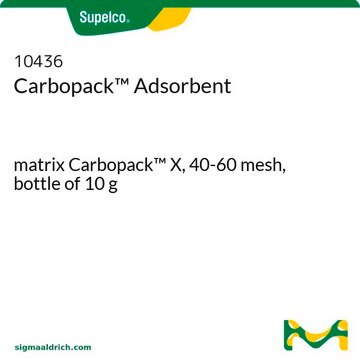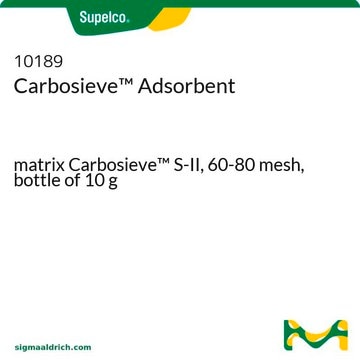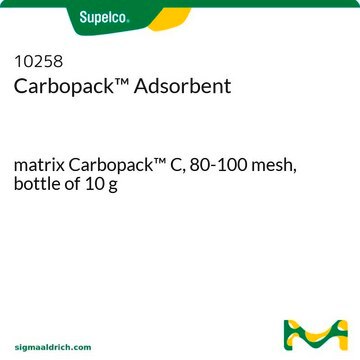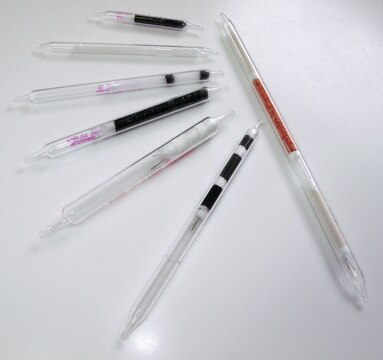10477-U
Carboxen® Adsorptionsmittel
matrix Carboxen® 1000, 40-60 mesh, bottle of 50 g
About This Item
Empfohlene Produkte
Produktlinie
Carboxen®
Form
powder
Verpackung
bottle of 50 g
Methode(n)
LPLC: suitable
Oberflächenbereich
~1200 m2/g
Matrix
Carboxen® 1000
Aktive Matrixgruppe
carbon
Partikelgröße
40-60 mesh
Porengröße
~0.16 cm3/g mesoporosity
~0.25 cm3/g macroporosity
~0.44 cm3/g microporosity
~10-12 Å pore diameter
Dichte
~0.50 g/mL (free fall density)
Trenntechnik
reversed phase
Suchen Sie nach ähnlichen Produkten? Aufrufen Leitfaden zum Produktvergleich
Verwandte Kategorien
Allgemeine Beschreibung
Anwendung
- Evaluation of selected solid adsorbents for passive sampling of atmospheric oil and natural gas non-methane hydrocarbons: This study assesses different adsorbents including Carboxen for capturing non-methane hydrocarbons in the air, crucial for environmental monitoring and regulatory compliance (Helmig et al., 2022).
- Application of Thin-Film Microextraction to Analyze Volatile Metabolites in A549 Cancer Cells: Discusses the application of Carboxen adsorbents in microextraction techniques for analyzing volatile compounds from cancer cells, demonstrating its utility in medical research and diagnostics (Filipiak et al., 2021).
- Analysis of volatile organic compounds in indoor environments: The study uses Carboxen adsorbents for sampling and analysis of indoor air pollutants through gas chromatography, highlighting its application in improving indoor air quality and health (Veenaas et al., 2020).
- New approach to resolve the humidity problem in VOC determination in outdoor air samples: This research addresses challenges in using Carboxen adsorbents for environmental VOC sampling, emphasizing improvements in the accuracy of air quality assessments (Maceira et al., 2017).
- Measurement of breakthrough volumes of volatile chemical warfare agents on a poly(2,6-diphenylphenylene oxide)-based adsorbent: This paper evaluates the efficiency of Carboxen adsorbents in capturing chemical warfare agents, indicating its potential in security and environmental protection applications (Kanamori-Kataoka et al., 2015).
Leistungsmerkmale und Vorteile
- Sphärisch
- Hart (Ball-Pan-Hardness >98 %)
- Stabil bis 400 °C
- Hohe Reinheit
- Einfaches Packing
- Stabil über den gesamten pH-Bereich
- Erzeugen keinen Gegendruck
- Hohe osmotische Schockstabilität
- Gestaffelte Porengröße (von Makro zu Meso zu Mikro)
Sonstige Hinweise
Rechtliche Hinweise
Lagerklassenschlüssel
11 - Combustible Solids
WGK
nwg
Flammpunkt (°F)
Not applicable
Flammpunkt (°C)
Not applicable
Choose from one of the most recent versions:
Analysenzertifikate (COA)
Sorry, we don't have COAs for this product available online at this time.
If you need assistance, please contact Kundensupport
Besitzen Sie dieses Produkt bereits?
In der Dokumentenbibliothek finden Sie die Dokumentation zu den Produkten, die Sie kürzlich erworben haben.
Kunden haben sich ebenfalls angesehen
Artikel
Carbon Molecular sieves (CMS) are a versatile range of adsorbents that can be tailored for specific applications. Supelco® scientists have been synthesizing synthetic CMS carbons for several decades, starting from tailoring of the starting polymers/copolymers, to modifying the final properties of the subsequent CMS carbon.
Unser Team von Wissenschaftlern verfügt über Erfahrung in allen Forschungsbereichen einschließlich Life Science, Materialwissenschaften, chemischer Synthese, Chromatographie, Analytik und vielen mehr..
Setzen Sie sich mit dem technischen Dienst in Verbindung.



